Habitat Quality Assessment in the Yellow River Delta Based on Remote Sensing and Scenario Analysis for Land Use/Land Cover
Abstract
1. Introduction
2. Study Area
3. Data and Methods
3.1. Data Sources
3.2. Forecasting Future LULCs under Multiple Scenarios
3.3. Habitat Quality Assessment
4. Results
4.1. Characteristics of Land Use/Cover Change
4.1.1. Spatiotemporal Change of LULCs
4.1.2. Landscape Pattern Index Change
4.2. Characteristics of Habitat Quality Change
4.2.1. Habitat Quality Spatiotemporal Change from 2000 to 2020
4.2.2. Habitat Quality Change Characteristics in 2030
5. Discussion and Conclusions
5.1. Discussion
5.2. Conclusions
- (1)
- From 2000 to 2020, construction land, salt pan, and mariculture expanded at high speed, whereas the proportion of coastal wetlands shrunk drastically. On the whole, the LULC had a spatial distribution pattern characteristic of “shallow water, followed by coastal wetlands, constructed wetlands, lands with the multi-type mixed region” from sea to land. The LULC pattern within a 20 km radius from the coastline varied most significantly due to the high intensity of human development activities and the process of erosion and deposition in coastal zones and estuarine deltas.
- (2)
- From 2000 to 2020, the habitat quality was generally at an intermediate level but with a downward trend. The high habitat quality was mainly distributed along the beaches, and the low habitat quality was distributed primarily on urban land and industrial and mining land. As the distance from the coastline becomes closer, the habitat quality declines more significantly. In the range of 0–20 km, many coastal wetlands were reclaimed, and mariculture and salt pan increased rapidly, which caused the habitat quality to decline most significantly.
- (3)
- In 2030, the habitat quality index under the BS, the SD, and the EP scenarios are 0.455, 0.447, and 0.470, respectively. The habitat quality decreases under the BS and the SD scenarios but increases under the EP scenario. Land use planning and ecological protection work should be coordinated and rationally arranged for various land types to improve the YRD habitat quality.
Author Contributions
Funding
Institutional Review Board Statement
Informed Consent Statement
Data Availability Statement
Acknowledgments
Conflicts of Interest
Appendix A
| LULC Category | 2000 | 2010 | 2020 | 2000–2010 | 2010–2020 | 2000–2020 |
|---|---|---|---|---|---|---|
| Area (km2) | Area Change (km2) | |||||
| Proportion (%) | Rate of Change (%) | |||||
| Construction land | 1320.64 | 1742.98 | 1836.59 | 422.34 | 93.61 | 515.95 |
| 10.81 | 14.27 | 15.03 | 31.98 | 5.37 | 39.07 | |
| Farmland | 4351.33 | 4917.27 | 4713.34 | 565.94 | −203.93 | 362.01 |
| 35.62 | 40.25 | 38.58 | 13.01 | −4.15 | 8.32 | |
| Forest | 146.43 | 112.65 | 163.00 | −33.78 | 50.35 | 16.57 |
| 1.20 | 0.92 | 1.33 | −23.07 | 44.70 | 11.32 | |
| Grassland | 555.34 | 155.58 | 135.31 | −399.76 | −20.27 | −420.03 |
| 4.55 | 1.27 | 1.11 | −71.98 | −13.03 | −75.63 | |
| Inland freshwaters | 396.27 | 407.60 | 564.24 | 11.33 | 156.64 | 167.97 |
| 3.24 | 3.34 | 4.62 | 2.86 | 38.43 | 42.39 | |
| Coastal saltwater | 2078.17 | 996.10 | 782.62 | −1082.07 | −213.48 | −1295.55 |
| 17.01 | 8.15 | 6.41 | −52.07 | −21.43 | −62.34 | |
| Salt pan | 376.77 | 675.13 | 676.93 | 298.36 | 1.80 | 300.16 |
| 3.08 | 5.53 | 5.54 | 79.19 | 0.27 | 79.67 | |
| Mariculture | 630.24 | 784.79 | 902.97 | 154.55 | 118.18 | 272.73 |
| 5.16 | 6.42 | 7.39 | 24.52 | 15.06 | 43.27 | |
| Unused land | 252.59 | 111.88 | 77.80 | −140.71 | −34.08 | −174.79 |
| 2.07 | 0.92 | 0.64 | −55.71 | −30.46 | −69.20 | |
| Shallow water | 2109.10 | 2312.90 | 2364.08 | 203.80 | 51.18 | 254.98 |
| 17.26 | 18.93 | 19.35 | 9.66 | 2.21 | 12.09 | |
| Year | Distance from the Coastline | LULC Types | |||||||||
|---|---|---|---|---|---|---|---|---|---|---|---|
| (km) | 1 | 2 | 3 | 4 | 5 | 6 | 7 | 8 | 9 | 10 | |
| 2000 | −20–−10 | - | - | - | - | - | - | - | - | - | 307.56 |
| −10–0 | 0.09 | - | - | - | 0.03 | 0.94 | - | - | - | 1798.69 | |
| 0–10 | 92.44 | 22.51 | 6.48 | 28.66 | 54.35 | 1625.70 | 62.50 | 251.22 | 16.28 | 1.77 | |
| 10–20 | 142.49 | 356.83 | 39.44 | 223.72 | 131.27 | 395.82 | 234.75 | 209.01 | 69.02 | - | |
| 20–30 | 232.53 | 895.83 | 37.34 | 133.71 | 83.22 | 54.31 | 79.10 | 73.18 | 83.08 | - | |
| 30–40 | 217.82 | 946.35 | 25.31 | 61.81 | 52.19 | - | - | 54.49 | 51.51 | - | |
| 40–50 | 270.81 | 908.95 | 9.75 | 48.16 | 30.59 | - | 0.23 | 14.34 | 7.56 | - | |
| 50–60 | 254.86 | 809.90 | 9.62 | 35.98 | 23.07 | 1.22 | - | 17.51 | 18.77 | - | |
| 60–70 | 93.87 | 352.06 | 17.93 | 22.23 | 20.55 | - | - | 9.84 | 6.24 | - | |
| 70–80 | 15.59 | 56.78 | 0.52 | 0.98 | 0.84 | - | - | 0.63 | - | - | |
| 2010 | −20–−10 | - | - | - | - | - | - | - | - | - | 308.11 |
| −10–0 | 1.17 | - | - | - | 3.21 | 26.66 | - | - | - | 1769.20 | |
| 0–10 | 188.62 | 46.36 | 10.39 | 3.34 | 111.85 | 812.80 | 244.02 | 469.47 | 40.75 | 234.33 | |
| 10–20 | 243.69 | 630.46 | 40.34 | 18.97 | 104.61 | 154.65 | 345.25 | 194.13 | 70.26 | - | |
| 20–30 | 306.25 | 1075.34 | 26.56 | 42.64 | 78.74 | 1.97 | 85.77 | 54.63 | 0.40 | - | |
| 30–40 | 256.47 | 1020.96 | 16.06 | 46.60 | 38.68 | - | - | 30.68 | 0.03 | - | |
| 40–50 | 316.43 | 913.07 | 1.95 | 19.55 | 27.92 | - | - | 11.24 | 0.28 | - | |
| 50–60 | 302.63 | 812.82 | 4.89 | 14.53 | 20.52 | - | - | 15.49 | 0.16 | - | |
| 60–70 | 113.88 | 357.62 | 11.93 | 9.72 | 21.07 | - | - | 8.50 | - | - | |
| 70–80 | 13.77 | 59.34 | 0.52 | 0.23 | 0.93 | - | - | 0.63 | - | - | |
| 2020 | −20–−10 | - | - | - | - | - | - | - | - | - | 307.95 |
| −10–0 | 7.00 | - | - | - | 18.39 | 46.74 | - | - | - | 1727.85 | |
| 0–10 | 189.09 | 28.11 | 16.96 | 6.37 | 185.81 | 616.21 | 291.56 | 477.56 | 22.74 | 327.53 | |
| 10–20 | 254.02 | 569.49 | 51.42 | 18.50 | 148.44 | 116.24 | 310.72 | 279.37 | 54.17 | - | |
| 20–30 | 318.38 | 1035.29 | 48.03 | 40.03 | 84.74 | 3.42 | 74.59 | 67.49 | 0.40 | - | |
| 30–40 | 276.24 | 999.73 | 21.18 | 30.49 | 53.71 | - | - | 28.14 | 0.04 | - | |
| 40–50 | 333.00 | 892.22 | 2.43 | 18.03 | 28.74 | - | - | 15.73 | 0.30 | - | |
| 50–60 | 323.40 | 777.42 | 9.93 | 13.27 | 20.48 | - | - | 26.51 | 0.16 | - | |
| 60–70 | 121.16 | 350.61 | 12.50 | 8.40 | 22.76 | - | - | 7.49 | - | - | |
| 70–80 | 14.21 | 58.90 | 0.52 | 0.22 | 1.00 | - | - | 0.63 | - | - | |
References
- Stamps, J. Habitat. In Encyclopedia of Ecology; Jørgensen, S.E., Fath, B.D., Eds.; Academic Press: Oxford, UK, 2008; pp. 1807–1810. [Google Scholar]
- Hillard, E.M.; Nielsen, C.K.; Groninger, J.W. Swamp rabbits as indicators of wildlife habitat quality in bottomland hardwood forest ecosystems. Ecol. Indic. 2017, 79, 47–53. [Google Scholar] [CrossRef]
- Wang, C.; Chang, Y.; Hou, X.Y.; Liu, Y.B. Temporal and Spatial Evolution Characteristics of Habitat Quality in Jiaodong Peninsula based on Changes of Land Use Pattern. J. Geo-Inf. Sci. 2021, 23, 1809–1822. [Google Scholar]
- Liu, C.F.; Wang, C. Spatio-temporal evolution characteristics of habitat quality in the Loess Hilly Region based on land use change: A case study in Yuzhong county. Acta Ecol. Sin. 2018, 38, 7300–7311. [Google Scholar]
- Liu, F.T.; Xu, E.Q. Comparison of spatial-temporal evolution of habitat quality between Xinjiang corps and non-corps region based on land use. Chin. J. Appl. Ecol. 2020, 31, 2341–2351. [Google Scholar]
- Zhang, J.D.; Hull, V.; Huang, J.Y.; Yang, W.; Zhou, S.Q.; Xu, W.H.; Huang, Y.; Ouyang, Z.Y.; Zhang, H.M.; Liu, J.G. Natural recovery and restoration in giant panda habitat after the Wenchuan earthquake. For. Ecol. Manag. 2014, 319, 1–9. [Google Scholar] [CrossRef]
- Cui, S.P.; Luo, X.; Li, C.W.; Jiang, Z.G. Predicting the potential distribution of white-lipped deer using the MaxEnt model. Biodivers. Sci. 2018, 26, 171–176. [Google Scholar] [CrossRef]
- Ohnson, E.T.; Benitez, M.E.; Fuentes, A.; McLean, C.R.; Norford, A.B.; Ordonez, J.C.; Beehner, J.C.; Bergman, T.J. High density of white-faced capuchins (Cebus capucinus) and habitat quality in the Taboga Forest of Costa Rica. Am. J. Primatol. 2020, 82, e23096. [Google Scholar]
- Wang, J.; Liu, H.Y.; Li, Y.F.; Liu, L.; Xie, F.F.; Lou, C.R.; Zhang, H.B. Effects of Spartina alterniflora invasion on quality of the red-crowned crane (Grus japonensis) wintering habitat. Environ. Sci. Pollut. Res. 2019, 26, 21546–21555. [Google Scholar] [CrossRef]
- Morton, D.C.; Defries, R.S.; Shimabukuro, Y.E.; Anderson, L.O.; Arai, E.; Del, B.; Morisette, J. Cropland expansion changes deforestation dynamics in the southern Brazilian Amazon. Proc. Natl. Acad. Sci. USA 2006, 103, 14637–14641. [Google Scholar] [CrossRef]
- Macedo, M.N.; Defries, R.S.; Morton, D.C.; Stickler, C.M.; Galford, G.L.; Shimabukuro, Y.E. Decoupling of deforestation and soy production in the southern Amazon during the late 2000s. Proc. Natl. Acad. Sci. USA 2018, 109, 1341–1346. [Google Scholar] [CrossRef]
- Xu, X.; Xie, Y.J.; Ke, Q.; Luo, Z.K.; Wang, X.R. Detecting the response of bird communities and biodiversity to habitat loss and fragmentation due to urbanization. Sci. Total Environ. 2018, 624, 1561–1576. [Google Scholar] [CrossRef]
- Llerena-Montoya, S.; Velastegui-Montoya, A.; Zhirzhan-Azanza, B.; Herrera-Matamoros, V.; Adami, M.; Lima, A.D.; Moscoso-Silva, F.; Encalada, L. Multitemporal analysis of land use and land cover within an oil block in the Ecuadorian Amazon. Int. J. Geo-Eng. 2021, 10, 191. [Google Scholar] [CrossRef]
- Velastegui-Montoya, A.; Lima, A.D.; Adami, M. Multitemporal analysis of deforestation in response to the construction of the Tucuruí Dam. Int. J. Geosci. 2020, 9, 583. [Google Scholar] [CrossRef]
- Parihar, S.M.; Pandey, V.K.; Shree, K.; Moin, K.; Ali, M.B.; Narasimhan, K.; Rai, J.; Kamil, A. Land use dynamics and impact on regional climate Post-Tehri Dam in the Bhilangana Basin, Garhwal Himalaya. Sustainability 2022, 14, 10221. [Google Scholar] [CrossRef]
- Qi, Z.X.; Xu, W.H.; Xiong, X.Y.; Ouyang, Z.Y. Assessment of potential habitat for Ursus thibetanus in the Qinling Mountains. Biodivers. Sci. 2011, 19, 343–352. [Google Scholar]
- Sun, X.Y.; Jiang, Z.; Liu, F.; Zhang, D.Z. Monitoring spatio-temporal dynamics of habitat quality in Nansihu Lake basin, eastern China, from 1980 to 2015. Ecol. Indic. 2019, 102, 716–723. [Google Scholar] [CrossRef]
- Antomi, Y. Model Habitat Quality in the Future in Padang City. Int. J. GEOMATE 2018, 16, 99–107. [Google Scholar] [CrossRef]
- Ye, X.; Li, J.; Wang, A.J. Sedimentary environment and its response to anthropogenic impacts in the coastal wetland of the Qi’ao Island, Zhujiang River Estuary. Haiyang Xuebao 2018, 40, 79–89. [Google Scholar]
- Li, H.D.; Gao, J.X. Management strategy for biodiversity conservation to adapt to climate change in China. Acta Ecol. Sin. 2020, 40, 3844–3850. [Google Scholar]
- Aretano, R.; Semeraro, T.; Petrosillo, I.; De Marco, A.; Pasimeni, M.R.; Zurlini, G. Mapping ecological vulnerability to fire for effective conservation management of natural protected areas. Ecol. Model. 2015, 295, 163–175. [Google Scholar] [CrossRef]
- Chen, J.; Wang, S.Y.; Mao, Z.P. Monitoring wetland changes in Yellow River Delta by remote sensing during 1976–2008. Prog. Geogr. 2011, 30, 585–592. [Google Scholar]
- Li, Y.L.; Kong, X.L.; Han, M.; Wang, M.; Pan, B.; Huang, S.P. Analysis of surface water changes and driving force in Yellow River Delta from 1986 to 2016. Trans. Chin. Soc. Agric. Eng. 2019, 35, 105–113. [Google Scholar] [CrossRef]
- Kong, D.X.; Miao, C.Y.; Borthwick, A.G.L.; Duan, Q.Y.; Liu, H.; Sun, Q.H.; Ye, A.Z.; Di, Z.H.; Gong, W. Evolution of the Yellow River Delta and its relationship with runoff and sediment load from 1983 to 2011. J. Hydrol. 2015, 520, 157–167. [Google Scholar] [CrossRef]
- Duan, X.F.; Xu, X.G. Emergy Analysis for Sustainable Development of Resources-Environment-Economy System in the Yellow River Delta. Prog. Geogr. 2006, 25, 45–55. [Google Scholar]
- Qi, Y.; Li, J.S.; Ma, Y.W.; He, J.; Fu, G.; Shen, Q.; Zhao, C.Y.; Cao, M. Distribution and risk assessment of heavy metals of surface sediments in intertidal flats of the Yellow River Delta, China. Res. Environ. Sci. 2020, 33, 1488–1496. [Google Scholar]
- Li, X.W.; Hou, X.Y.; Song, Y.; Shan, K.; Zhu, S.Y.; Yu, X.B.; Mo, X.Q. Assessing Changes of Habitat Quality for Shorebirds in Stopover Sites: A Case Study in Yellow River Delta, China. Wetlands 2018, 39, 67–77. [Google Scholar] [CrossRef]
- Wang, H. Study on Spatial-Temporal Variation of Soil Salt in the Yellow River Delta; Nanjing University: Nanjing, China, 2005. [Google Scholar]
- Li, R.S. Primary study on the superiorities, problems and countermeasures of the recent deposited delta of the Yellow River. J. Nat. Resour. 1990, 5, 149–155. [Google Scholar]
- Liu, Y.L. Strengthen the protection of Yellow River Delta Wetland. Green China 2013, 20, 36–41. [Google Scholar]
- Li, B.L.; Xu, X.G.; Lin, H.P. A method of investigating natural resources by computer-based interpretation of remote sensing images. Geogr. Territ. Res. 2002, 18, 34–37. [Google Scholar]
- Xie, X.L.; Ye, L.; Kang, X.Q.; Zeng, L.Q.; Farouk, A. Land Use Classification Using Improved U-Net in Remote Sensing Images of Urban and Rural Planning Monitoring. Sci. Program. 2022, 2022, 3125414. [Google Scholar] [CrossRef]
- Tan, Q.L. Urban building extraction from VHR multi-spectral images using object-based classification. Acta Geod. Et Cartogr. Sin. 2010, 39, 618–623. [Google Scholar]
- Dang, Y.M.; Yang, M.H.; Chang, Z.K. Research on the application of SPOT5 image visual interpretation in the updating of Land-Use types. Geomat. Spat. Inf. Technol. 2009, 32, 125–127. [Google Scholar]
- Cao, Y.; Mo, L.J.; Li, Y.; Zhang, W.M. Wetland landscape ecological classification: Research progress. Chin. J. Appl. Ecol. 2009, 20, 3084–3092. [Google Scholar]
- Konarska, K.M.; Sutton, P.C.; Castellon, M. Evaluating scale dependence of ecosystem service valuation: A comparison of NOAA-AVHRR and Landsat TM datasets. Ecol. Econ. 2002, 41, 491–507. [Google Scholar] [CrossRef]
- Suo, A.N.; Yu, Y.H.; Han, F.W. Response of ecosystem service value to wetland landscape pattern change in Panjin region of Liaohe Delta. Ecol. Econ. 2011, 6, 147–151. [Google Scholar]
- Costanza, R.; d’Arge, R.; de Groot, R.; Farber, S.; Grasso, M.; Hannon, B.; Limburg, K.; Naeem, S.; O’Neill, R.V.; Paruelo, J.; et al. The value of the world’s ecosystem services and natural capital. Nature 1997, 387, 253–260. [Google Scholar] [CrossRef]
- Di, X.H.; Hou, X.Y.; Wu, L. Land use classification system for China’s coastal zone based on remote sensing. Resour. Sci. 2014, 36, 463–472. [Google Scholar]
- Liang, X.; Guan, Q.; Clarke, K.C.; Liu, S.; Wang, B.; Yao, Y. Understanding the drivers of sustainable land expansion using a patch-generating land use simulation (PLUS) model: A case study in Wuhan, China. Comput. Environ. Urban Syst. 2021, 85, 101569. [Google Scholar] [CrossRef]
- Wang, J.N.; Wang, W.C.; Hai, M.M. Simulation analysis of land use change in Shandong Province based on PLUS model. Territ. Nat. Resour. Study 2022, 6, 1–8. [Google Scholar]
- Lin, T.; Yang, M.Z.; Wu, D.F.; Liu, F.; Yang, J.H.; Wang, Y.J. Spatial correlation and prediction of land use carbon storage based on the InVEST-PLUS model-a case study in Guangdong Province. China Environ. Sci. 2022, 42, 4827–4839. [Google Scholar]
- Yang, S.; Su, H.; Zhao, G.P. Multi-cenario simulation of urban ecosystem service value based on PLUS model: A case study of Hanzhong city. J. Arid Land Res. Environ. 2022, 36, 86–95. [Google Scholar]
- Yang, W.J.; Du, J.G.; He, H.G.; Yang, W.J.; Chen, L.Y. Urban growth boundary delimitation in Guangzhou city based on PLUS-UGB multi-scenarios simulation. Geospat. Inf. 2022, 20, 38–42. [Google Scholar]
- Deng, Y.; Jiang, W.G.; Wang, W.J.; Lu, J.X.; Chen, K. Urban expansion led to the degradation of habitat quality in the Beijing-TianjinHebei Area. Acta Ecol. Sin. 2018, 38, 4516–4525. [Google Scholar]
- Chu, L.; Huang, C.; Liu, Q.S.; Liu, G.H. Changes of coastal zone landscape spatial patterns and ecological quality in Liaoning Province from 2000 to 2010. Resour. Sci. 2015, 37, 1962–1972. [Google Scholar]
- Wang, H.; Zhang, H.Y.; Zhang, R.F.; Zhang, A.J.; Zhou, D.M. Effects of salt pan construction on surrounding soil and vegetation in coastal saline-alkaline area. Ecol. Environ. Sci. 2010, 19, 1242–1245. [Google Scholar]
- Wang, C. Biodiversity Assessment Spatiotemporal Characteristics of Jiaodong Peninsula Based on LUCC; Shandong Normal University: Jinan, China, 2020. [Google Scholar]
- Bai, L.M.; Feng, X.H.; Sun, R.F.; Gao, H. Spatial and temporal responses of habitat quality to urbanization: A case study of Changchun City, Jilin Province, China. Chin. J. Appl. Ecol. 2020, 31, 1267–1277. [Google Scholar]
- Chu, L.; Zhang, X.R.; Wang, T.W.; Li, Z.X.; Cai, C.F. Spatial-temporal evolution and prediction of urban landscape pattern and habitat quality based on CA-Markov and InVEST model. Chin. J. Appl. Ecol. 2018, 29, 4106–4118. [Google Scholar]
- Wu, J.S.; Cao, Q.W.; Shi, S.Q.; Lu, Z.Q. Spatio-temporal variability of habitat quality in Beijing-Tianjin-Hebei Area based on land use change. Chin. J. Appl. Ecol. 2015, 26, 3457–3466. [Google Scholar]
- Zhang, W.J.; Sun, X.Y.; Shan, R.F. Effects of land use change on habitat quality based on InVEST model in Shandong Peninsula. Environ. Ecol. 2019, 1, 15–23. [Google Scholar]
- Sharp, R.; Tallis, H.T.; Ricketts, T.; Guerry, A.D.; Wood, S.A.; Chaplin-Kramer, R.; Nelson, E.; Ennaanay, D.; Wolny, S.; Olwero, N.; et al. InVEST +VERSION+ User’s Guide; The Natural Capital Project; Stanford University; University of Minnesota; The Nature Conservancy; World Wildlife Fund: Stanford, CA, USA, 2016. [Google Scholar]
- Feng, S.; Sun, R.H.; Chen, L.D. Spatio-temporal variability of habitat quality based on land use pattern change in Beijing. Acta Ecol. Sin. 2018, 38, 4167–4179. [Google Scholar]
- Xu, L.T.; Chen, S.S.; Xu, Y.; Li, G.Y.; Su, W.Z. Impacts of Land-Use Change on Habitat Quality during 1985–2015 in the Taihu Lake Basin. Sustainability 2019, 11, 3513. [Google Scholar] [CrossRef]
- He, J.H.; Huang, J.L.; Li, C. The evaluation for the impact of land use change on habitat quality: A joint contribution of cellular automata scenario simulation and habitat quality assessment model. Ecol. Model. 2017, 366, 58–67. [Google Scholar] [CrossRef]
- Zhang, X.R.; Zhou, J.; Li, G.N.; Chen, C.; Li, M.M.; Luo, J.M. Spatial pattern reconstruction of regional habitat quality based on the simulation of land use changes from 1975 to 2010. J. Geogr. Sci. 2020, 30, 601–620. [Google Scholar] [CrossRef]
- Ding, Q.L.; Chen, Y.; Bu, L.T.; Ye, Y.M. Multi-Scenario analysis of habitat quality in the Yellow River Delta by coupling FLUS with InVEST model. Int. J. Environ. Res. Public Health 2021, 18, 2389. [Google Scholar] [CrossRef] [PubMed]
- Martinuzzi, S.; Januchowski-Hartley, S.R.; Pracheil, B.M.; McIntyre, P.B.; Plantinga, A.J.; Lewis, D.J.; Radeloff, V.C. Threats and opportunities for freshwater conservation under future land use change scenarios in the United States. Glob. Chang. Biol. 2014, 20, 113–124. [Google Scholar] [CrossRef] [PubMed]
- Nematollahi, S.; Fakheran, S.; Kienast, F.; Jafari, A. Application of InVEST habitat quality module in spatially vulnerability assessment of natural habitats (case study: Chaharmahal and Bakhtiari province, Iran). Env. Monit Assess 2020, 192, 487. [Google Scholar] [CrossRef] [PubMed]
- Evans, M.C.; Watson, J.E.M.; Fuller, R.A.; Venter, O.; Bennett, S.C.; Marsack, P.R.; Possingham, H.P. The Spatial Distribution of Threats to Species in Australia. BioScience 2011, 61, 281–289. [Google Scholar] [CrossRef]
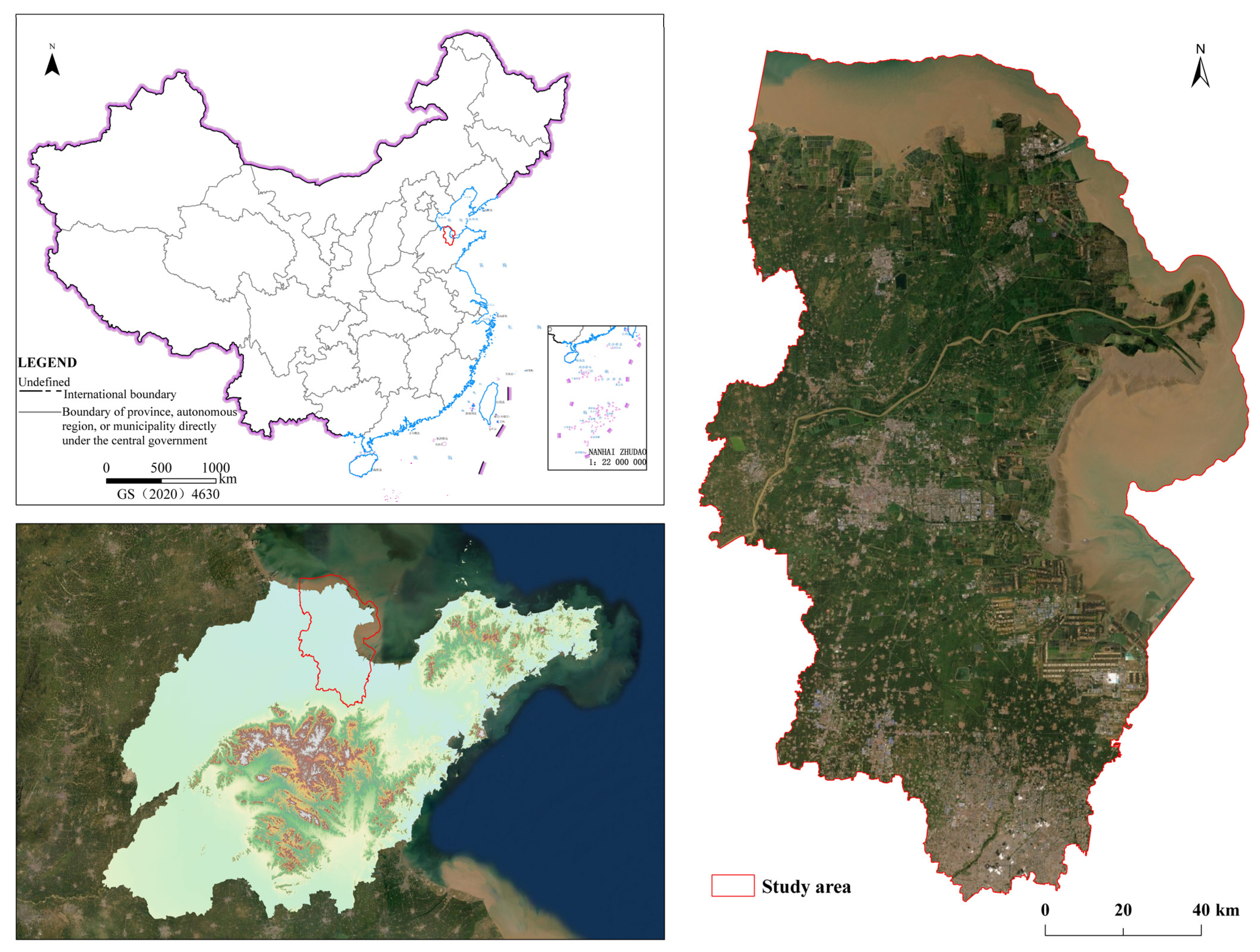
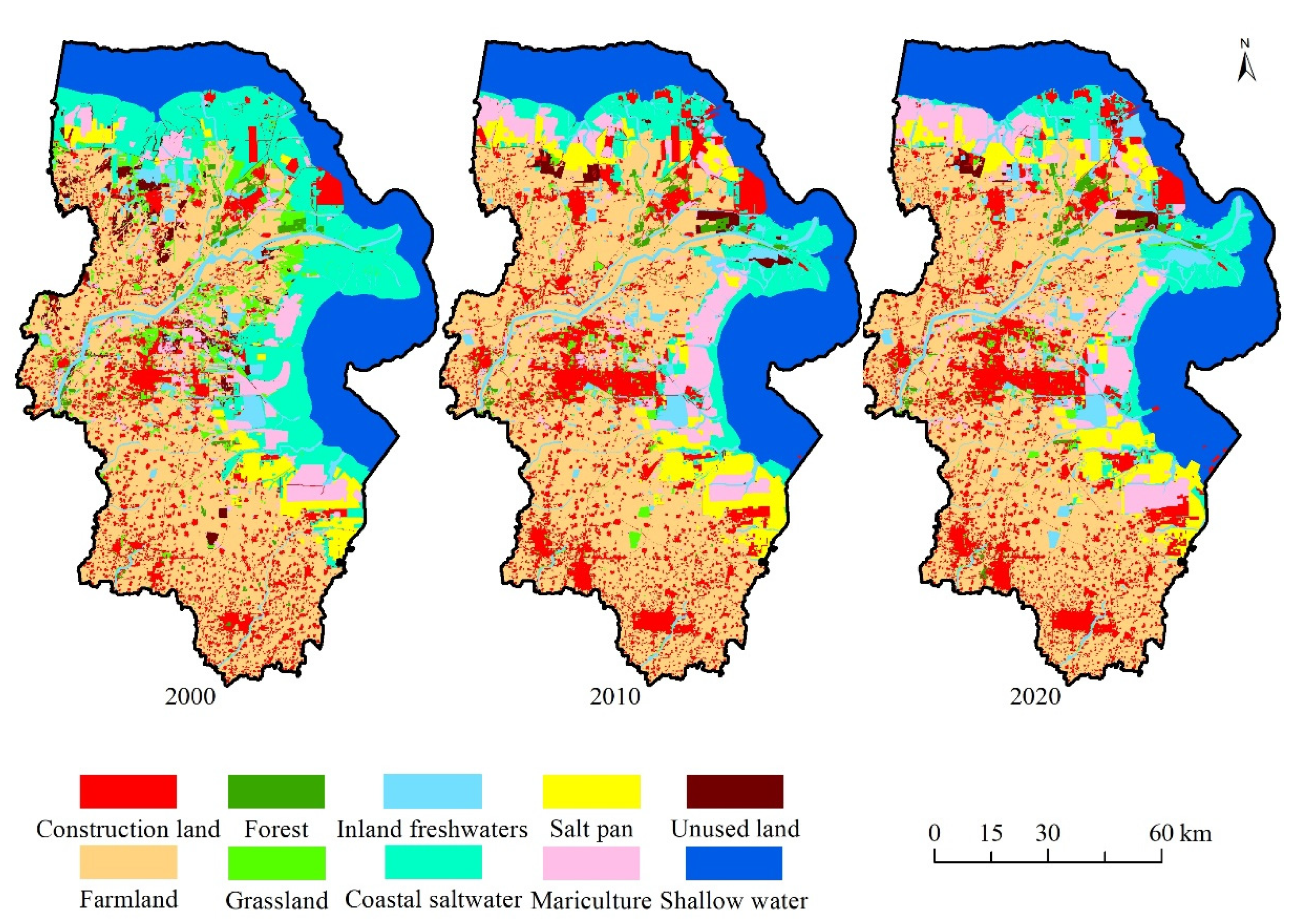
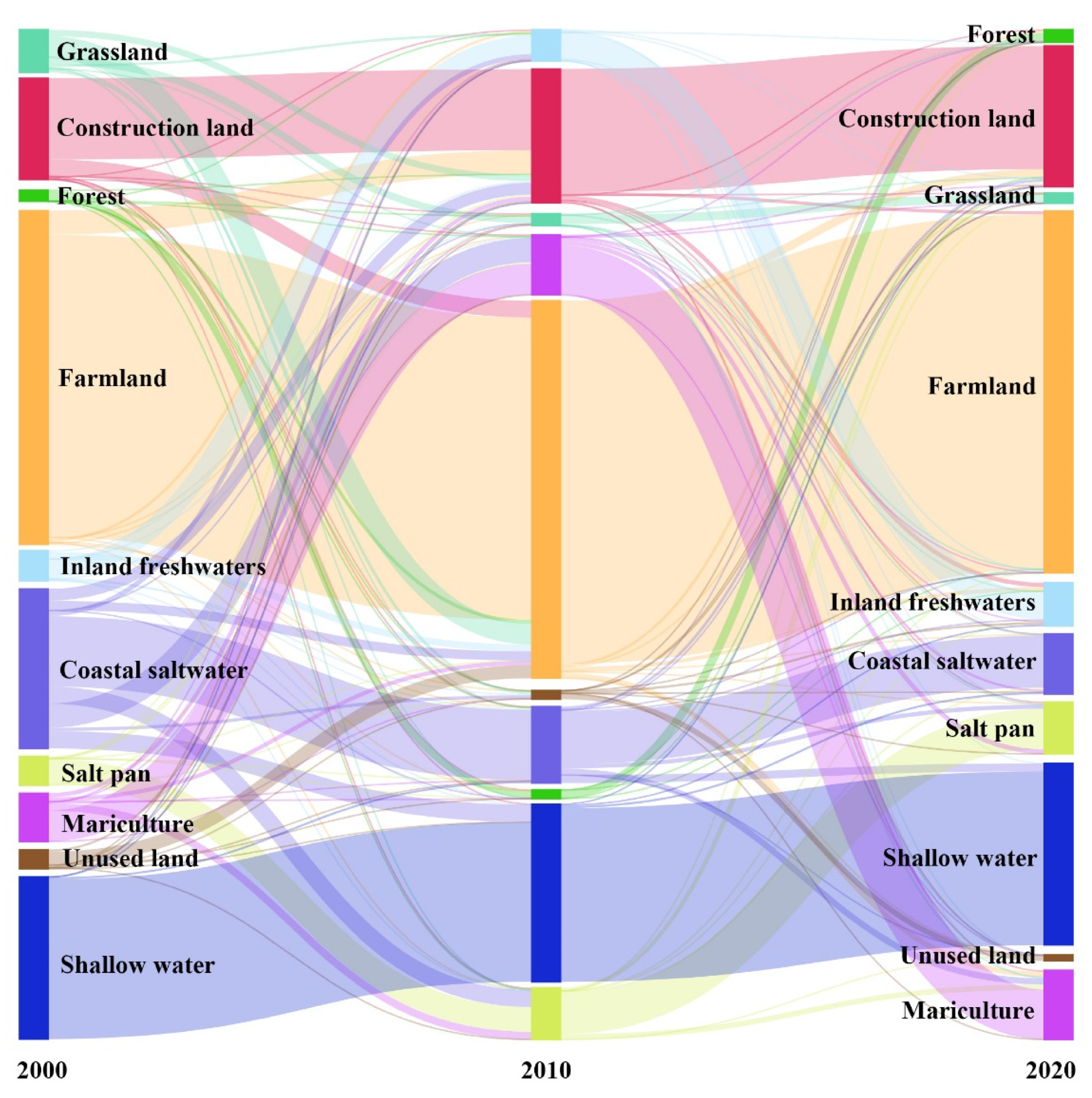
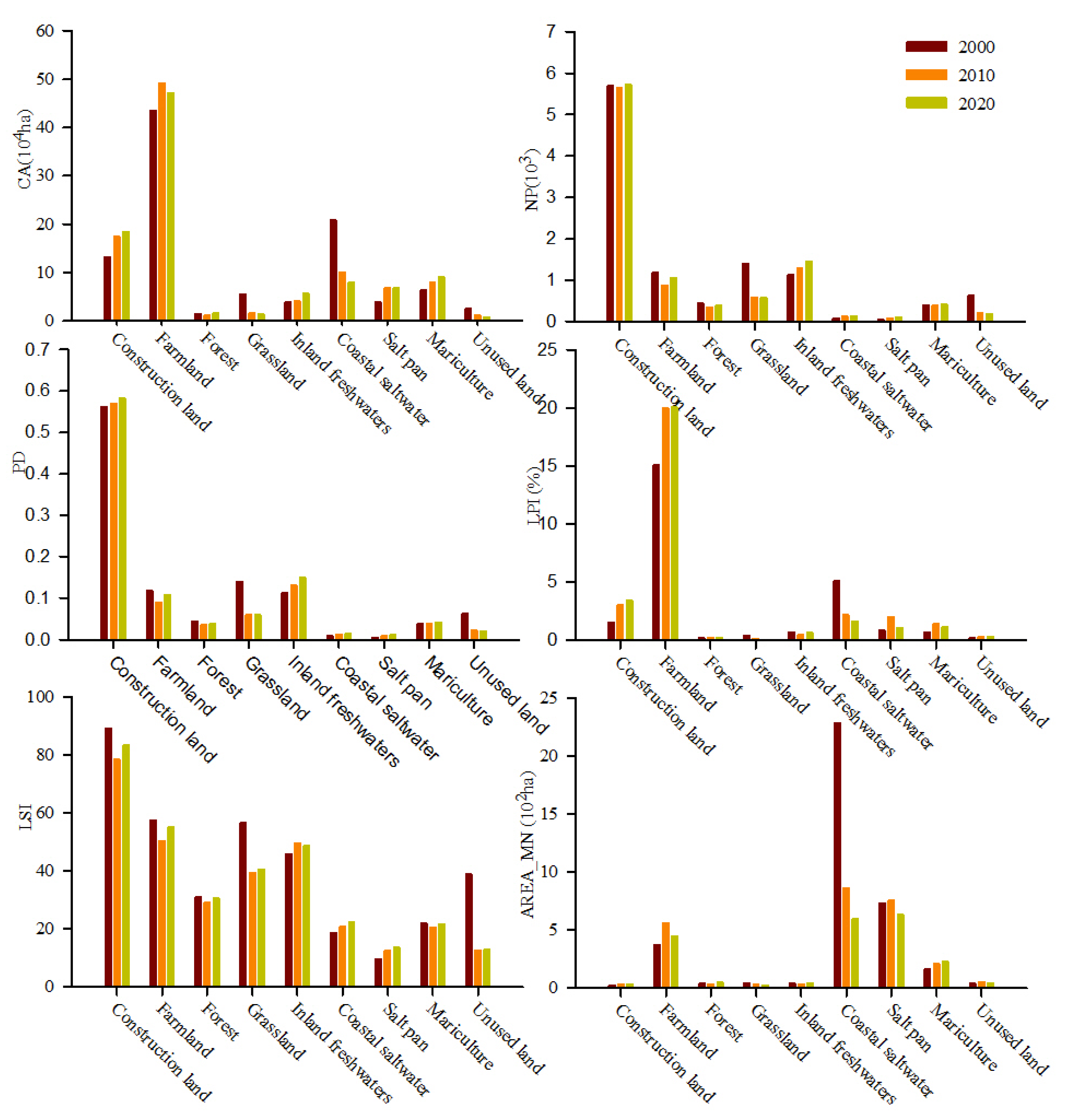
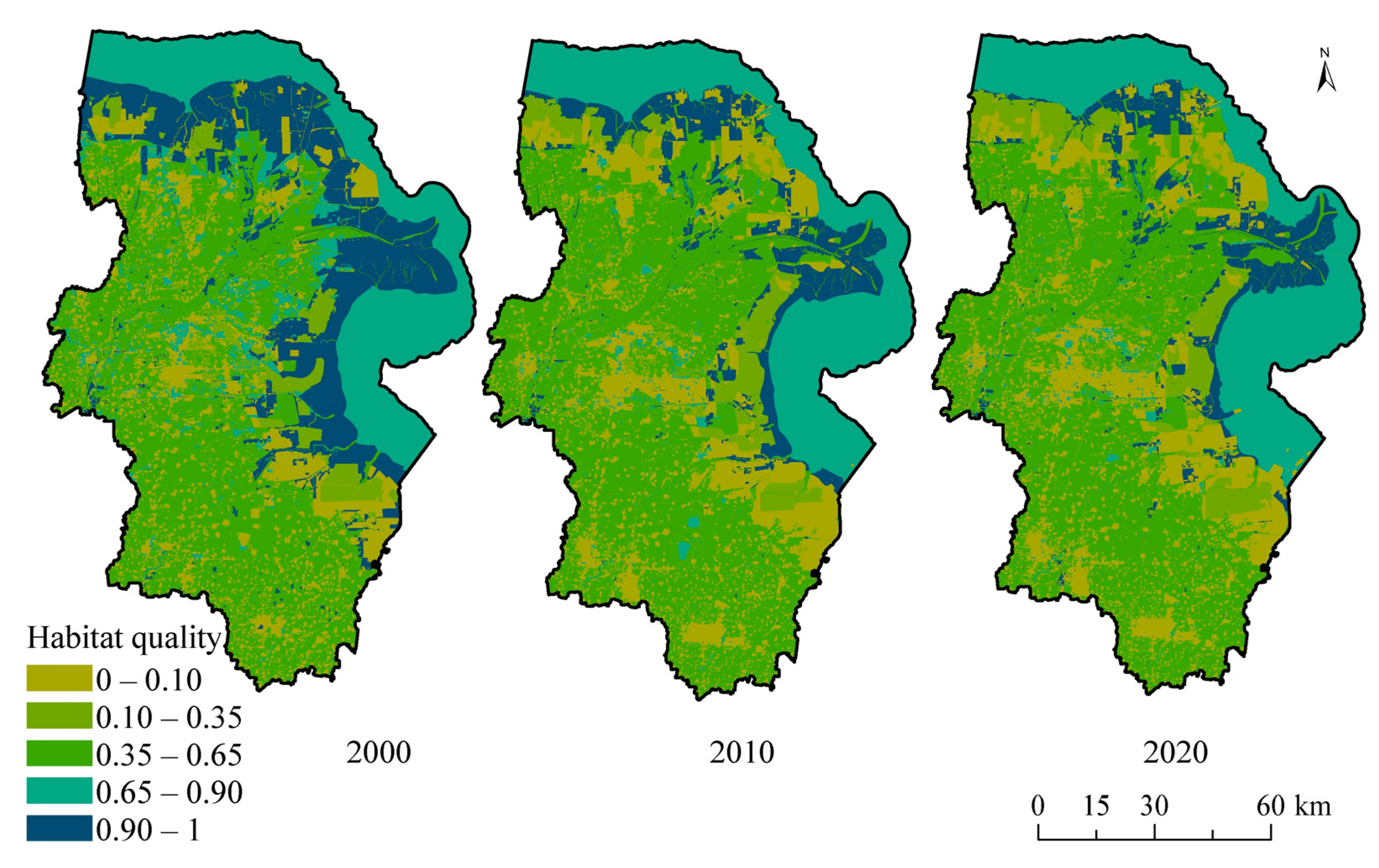
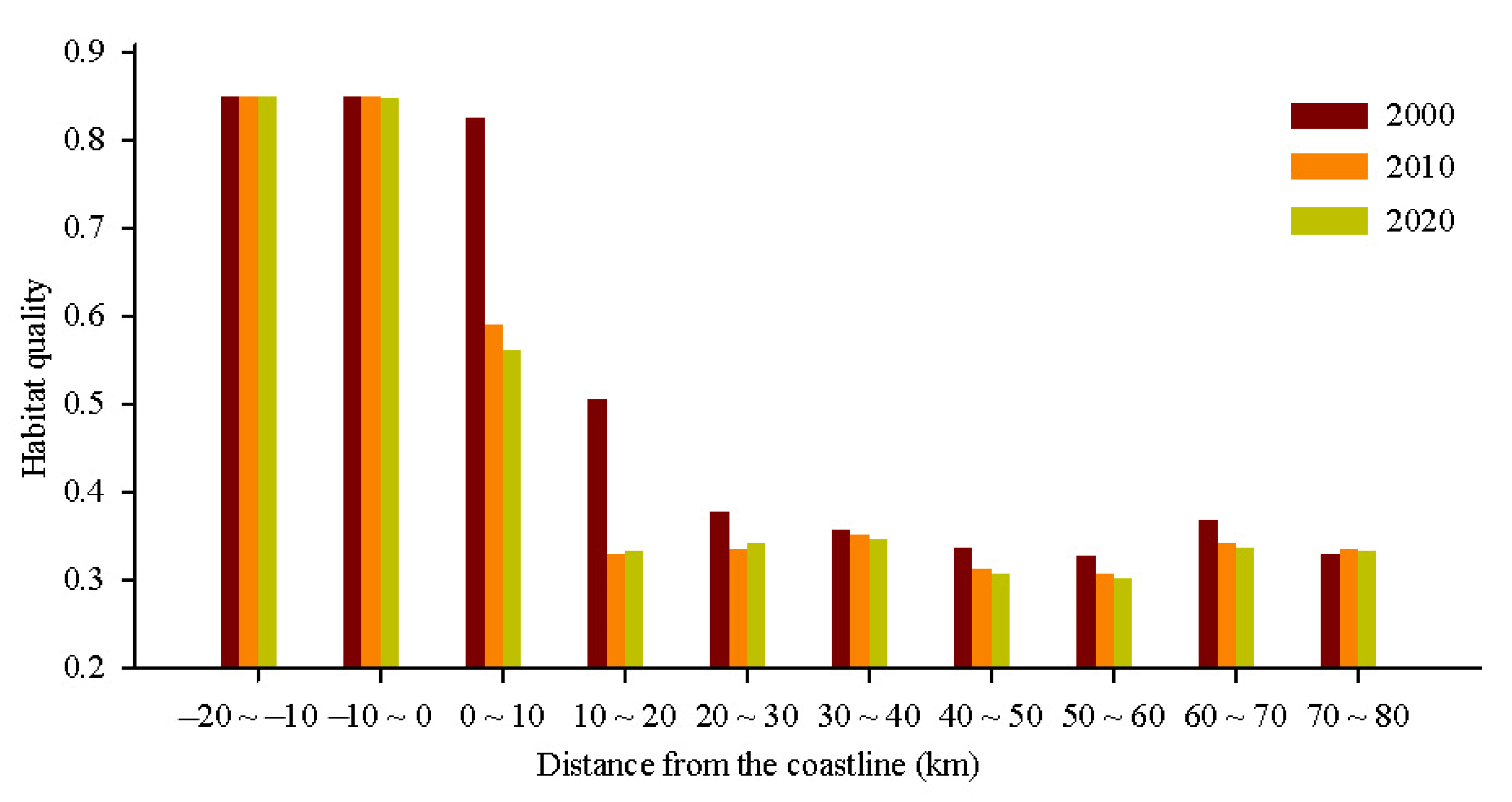
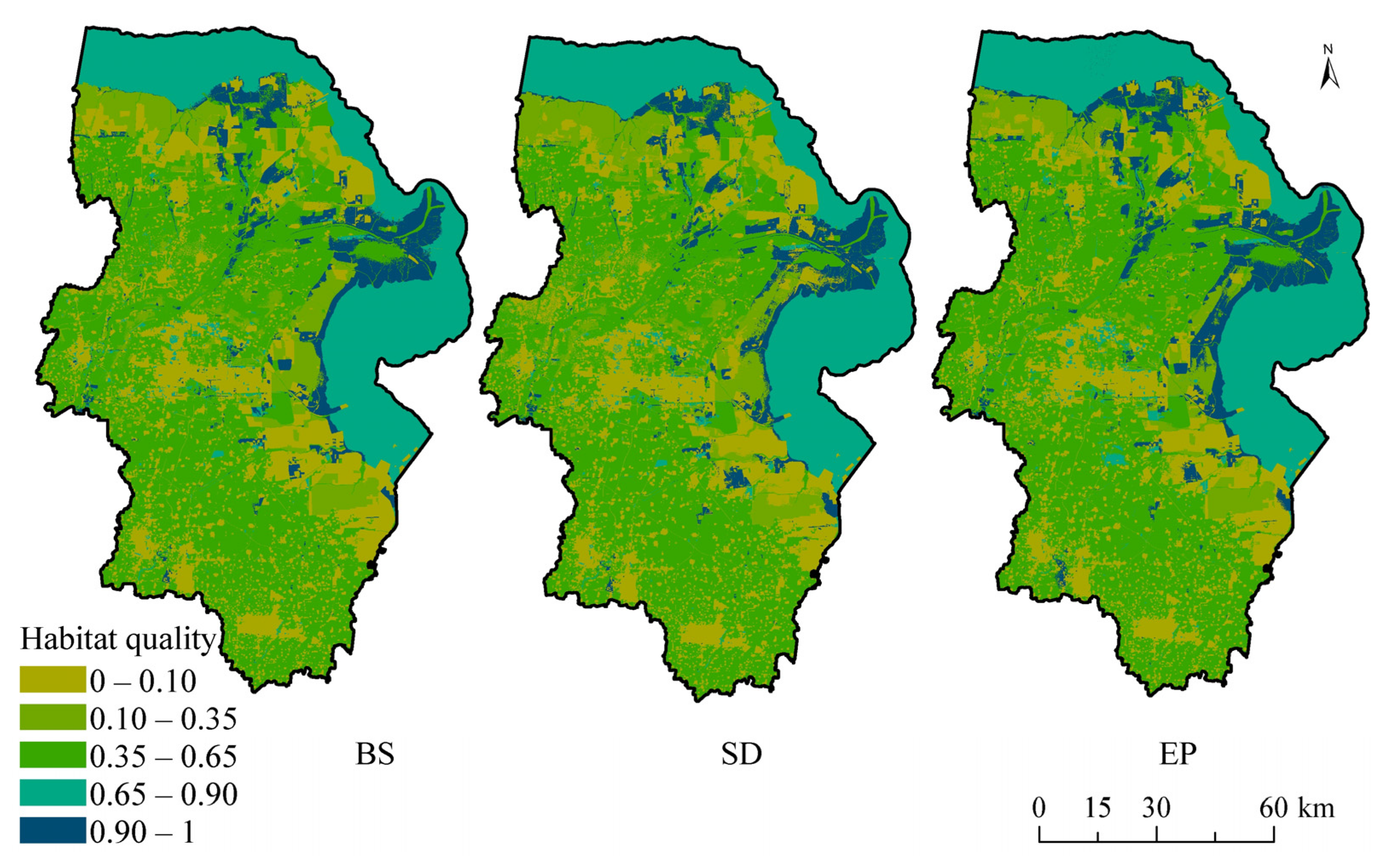

| THREAT | MAX_DIST | WEIGHT | DECAY |
|---|---|---|---|
| Construction land | 10 | 1 | exponential |
| Farmland | 3 | 0.6 | linear |
| Salt pan | 5 | 0.8 | exponential |
| Mariculture | 2 | 0.5 | linear |
| Unused land | 1 | 0.4 | linear |
| Sl. No. | LULC Category | HABITAT | Land Use/Cover | ||||
|---|---|---|---|---|---|---|---|
| Construction Land | Farmland | Salt Pan | Mariculture | Unused Land | |||
| 1 | Construction land | 0 | 0 | 0 | 0 | 0 | 0 |
| 2 | Farmland | 0.4 | 0.9 | 0 | 0.55 | 0.5 | 0.3 |
| 3 | Forest | 1 | 1 | 0.8 | 0.3 | 0.3 | 0.5 |
| 4 | Grassland | 0.8 | 1 | 0.85 | 0.5 | 0.55 | 0.5 |
| 5 | Inland freshwaters | 0.65 | 0.75 | 0.6 | 0.3 | 0.8 | 0.2 |
| 6 | Coastal saltwater | 1 | 0.95 | 0.8 | 0.75 | 0.85 | 0.35 |
| 7 | Salt pan | 0 | 0 | 0 | 0 | 0 | 0 |
| 8 | Mariculture | 0.35 | 0.8 | 0.3 | 0.45 | 0 | 0.2 |
| 9 | Unused land | 0 | 0 | 0 | 0 | 0 | 0 |
| 10 | Shallow water | 0.85 | 0.95 | 0.7 | 0.8 | 0.85 | 0.1 |
| Year | Diversity Index | Fragmentation Index | Aggregation and Dispersion Index | |||
|---|---|---|---|---|---|---|
| SHDI | SHEI | NP | PD | CONTAG | IJI | |
| 2000 | 1.6895 | 0.7689 | 10,992 | 1.0875 | 57.1812 | 71.5178 |
| 2010 | 1.5665 | 0.7129 | 9556 | 0.9649 | 60.5202 | 62.6021 |
| 2020 | 1.5988 | 0.7277 | 10,029 | 1.0179 | 59.4984 | 62.2804 |
Publisher’s Note: MDPI stays neutral with regard to jurisdictional claims in published maps and institutional affiliations. |
© 2022 by the authors. Licensee MDPI, Basel, Switzerland. This article is an open access article distributed under the terms and conditions of the Creative Commons Attribution (CC BY) license (https://creativecommons.org/licenses/by/4.0/).
Share and Cite
Liu, Y.; Han, M.; Wang, M.; Fan, C.; Zhao, H. Habitat Quality Assessment in the Yellow River Delta Based on Remote Sensing and Scenario Analysis for Land Use/Land Cover. Sustainability 2022, 14, 15904. https://doi.org/10.3390/su142315904
Liu Y, Han M, Wang M, Fan C, Zhao H. Habitat Quality Assessment in the Yellow River Delta Based on Remote Sensing and Scenario Analysis for Land Use/Land Cover. Sustainability. 2022; 14(23):15904. https://doi.org/10.3390/su142315904
Chicago/Turabian StyleLiu, Yubin, Mei Han, Min Wang, Chao Fan, and Hang Zhao. 2022. "Habitat Quality Assessment in the Yellow River Delta Based on Remote Sensing and Scenario Analysis for Land Use/Land Cover" Sustainability 14, no. 23: 15904. https://doi.org/10.3390/su142315904
APA StyleLiu, Y., Han, M., Wang, M., Fan, C., & Zhao, H. (2022). Habitat Quality Assessment in the Yellow River Delta Based on Remote Sensing and Scenario Analysis for Land Use/Land Cover. Sustainability, 14(23), 15904. https://doi.org/10.3390/su142315904






